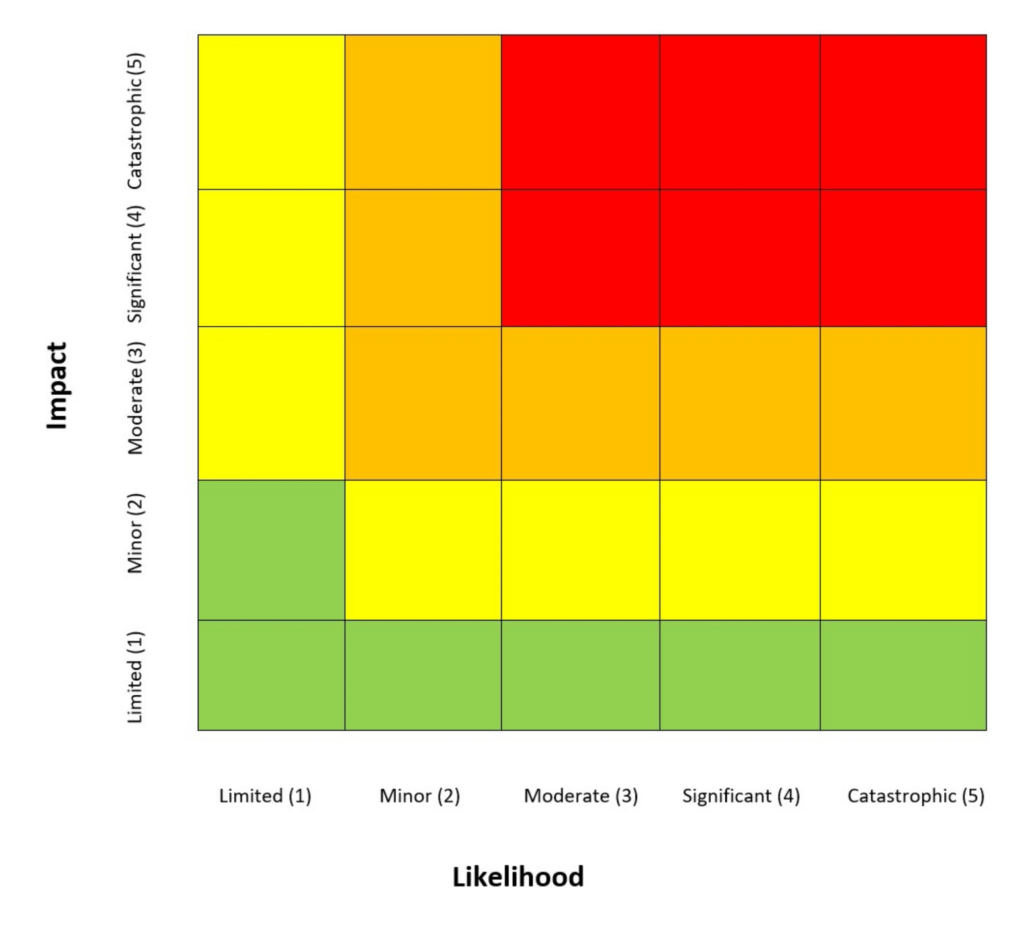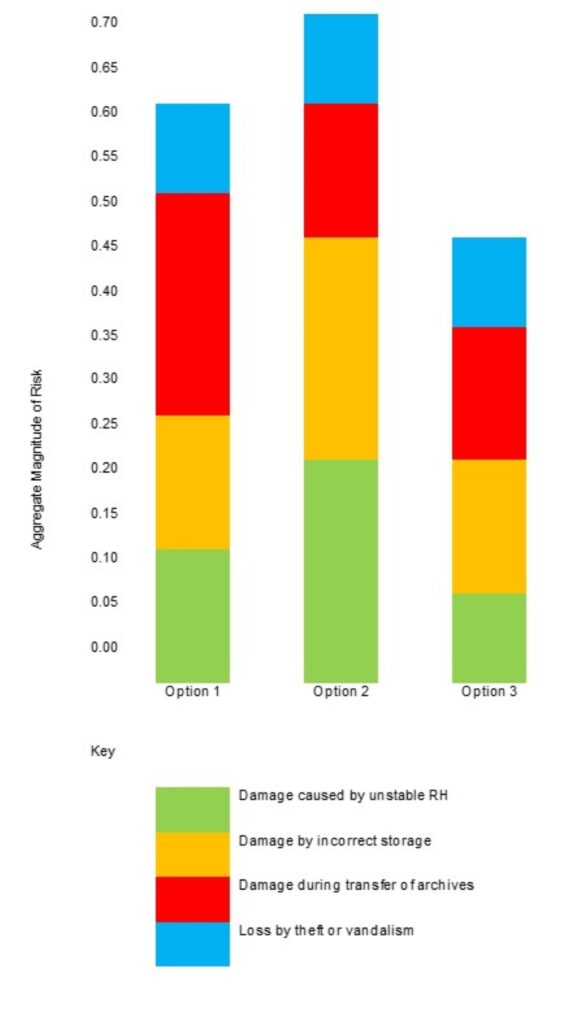Main section
Tabs Navigation
Tabs
Assessing the risk to collections
BS EN 17820:2023 (annex D.2) states that an organisation needs to have a policy that includes a commitment to the use of risk management in all planning and operations, in compliance with BS EN 16893:2018.
Decisions on instigating or continuing a split-site archive service can only be made after considering the likely and potential impact of such decisions on the service and the archive holdings. This section deals with risks to the collections (service considerations are dealt with above).
Different storage sites and arrangements present different risks. A risk assessment will evaluate the size of every risk affecting the archive collection. Risk management goes further, planning the use of resources to minimise the risks.
Risk assessment methodology
Start by bringing together a group of experts to create the risk assessment and management plan. Your experts should include archive and conservation staff as well as emergency planning staff, building managers and your Fire and Rescue Service.
A useful method is to look at each option or site being considered and assess the risks from each of the ten agents of deterioration:
- physical forces – ranging from earthquake to transportation and handling damage
- fire
- water
- criminals – internal and external
- pests – inspects, vermin, mould
- contamination – chemical agents from the environment
- light and radiation – including ultraviolet and visible light
- incorrect temperature – including variations
- incorrect relative humidity – including variations
- custodial neglect
Of these risks a number may have sub-agents – water, for example, may be caused by plumbing faults or flooding – and for each risk, the likelihood of the risk occurring within a specified period of time and the impact on the collection if the risk should occur, must be assessed.
You should also assess each site for the risks described in BS EN 16893:2018 section 4.2. The standard describes the hazards and security considerations to take into consideration when selecting a site for a storage repository. Additionally, it describes several types of sites which would be unsuitable for an archive repository and a variety of methods to tackle the risks associated with these.
A useful way to visualise and evaluate these risks is to put together a ‘risk register’ that reviews each option against a set of criteria. As an example, a suggested format may include the following columns:
Risk reference number – An ID number given to a risk, to make it easier to track
Agent of deterioration/service risk – Which of the 10 agents of deterioration is most likely to cause the risk to occur
Sub agent/risk – Any other agents which might be a contributing factor in causing a risk to occur
Likelihood – The chances of each particular risk occurring
Impact – The impact of the risk occurring. Usually numbered from 1-5, where 1 equates to ‘limited’ and 5 equates to ‘catastrophic’.
Risk rating – A combination of ‘likelihood’ and ‘impact’ scores. The total score will determine whether the risk rating is classed as ‘low’, ‘medium’, ‘high’ or ‘very high’.
Once you have assessed the impact and likelihood scores, plot them onto a matrix, which gives the overall risk rating:

Key:
Red = very high
Amber = high
Yellow = medium
Green = Low
In some circumstances organisations could be encouraged to accept a certain level of risk providing that the risk appetite of an organisation has been carefully considered. You can use the table to discuss which risks can be tolerated to achieve the objectives of the building. This toleration of risks should always be agreed by the governing body of the archive service. In general, the risk appetite for archive collections should be as low as reasonably practical.
Quantifying risk – a methodology
For each site, the magnitude of the risk (MR) is calculated. The magnitude of risk (MR) is the product of four variables:
1.Fractional susceptible (FS) – how much of the collection would be susceptible to this risk
FS=1 estimating the magnitude of the specific risks affecting the same collection held in two different buildings. If one of the options being considered was to store the collection across two sites, then this figure would change according to the percentage stored at each site.
2.Loss of value (LV) – reduction in the value of a collection for its intended purposes
Measured between 0 and 1, this is a relative status according to importance, usefulness or quality. In its study, The National Archives surveyed users to ascertain which aspects of a record were most valued by users. Users valued the information in a record but placed intrinsic value on the records. The National Archives assigned values to different types of material as follows:
| Assignment values | |||
|---|---|---|---|
| Assessment unit | Informational | Material | Cultural |
| Paper and parchment | 50% | 20% | 30% |
| Microfilm (archival masters) | 80% | 10% | 10% |
For example, water damage might result in a loss of material and cultural value but may not affect the informational value if the text remains clear. The loss of value would be less than 50% that is, <0.5
3.Probability (P) – the likelihood of this occurring within the next 100 years
Measured between 0 and 1 – here local community risk registers and the experience of team members
4.Extent (E) – extent to which damage would occur over the century
To reach the magnitude of risk (MR) to the collection the formula is MR = FS x LV x P x E
A simple table could calculate the risks:
| Agent of deterioration | Sub-agent/risk | Fraction susceptible (FS) | Loss in value (LV) | Probability (P) | Extent (E) | Magnitude of risk (MR) |
|---|---|---|---|---|---|---|
| Physical forces | Seismic event | 1 | ||||
| Risk of toppled shelves | 1 | |||||
| Incorrect storage (over and undercrowded) | 1 | |||||
| Incorrect handling | 1 | |||||
| Damage during transportation | 1 | |||||
| Destruction in crash during transportation | 1 | |||||
| Fire | Lack of fire suppression system | 1 | ||||
| Water | External flood | 1 | ||||
| Internal water ingress, for example roof leaks or plumbing faults | 1 | |||||
| Rising damp | 1 | |||||
| Criminals | Theft – burglary | 1 | ||||
| Theft – staff | 1 | |||||
| Vandalism | 1 | |||||
| Theft during transportation | 1 | |||||
| Pests | 1 | |||||
| Contaminants | Fallout from nearby buildings | 1 | ||||
| Light and radiation | Windows in the storage area | 1 | ||||
| Incorrect temperature and relative humidity (RH) | Mould development | 1 | ||||
| Damage caused by RH and temperature fluctuations | 1 | |||||
| Custodial neglect | Misplacement of items | 1 | ||||
| Collection abandonment | 1 |
The simple risk register and matrix described above could be used to compare the risks to archive collections on two sites/potential sites. The detailed quantification method could also be conveyed as:

Managing split-site risks
Identifying the storage requirements
The main means of managing risks to the collections is to specify collection storage sufficiently well. An off-site store should hold archive collections in the same high-quality storage conditions as the main archive service site. This will ensure management of most of the physical risks which you have quantified.
In drawing up a specification for a building or a contract with an external supplier, consider the following standards and guidance:
- BS EN 16893:2018 Conservation of Cultural Heritage – Specifications for location, construction and modification of buildings or rooms intended for the storage or use of heritage collections
- BS 4971:2017 Conservation and care of archive and library collections
- BS EN 17820 Conservation of Cultural Heritage – Specifications for the management of moveable cultural heritage collections
- Archive Service Accreditation
The building should be designed to allow for additional capacity according to the projected growth of collections. The guidance in the Archive Service Accreditation standard (PDF, 463 KB) – specifically section 1.4 – indicates a service should aim for a minimum of five years expansion space and provides support for calculating this.
Selecting material to be stored off-site
Archive services have generally followed similar rules in deciding which material should be stored off-site, prioritising public access and limiting the transfer of archives between sites. These considerations often mean that materials stored off-site are generally:
- Collections which have restricted access, for example items closed for several years under Data Protection legislation (some items might still need to be accessible if covered by the Freedom of Information Act (FOI)).
- Collections which have been digitised or microfilmed for access, and are available in surrogate form.
- Collections which are in an uncatalogued condition and therefore inaccessible to users (remember in this case items will still need to be accessible if covered by FOI). For such collections there must be sufficient information available to enable identification and retrieval of all or part of the collection if required by staff or users.
- Collections which are of a highly specialised nature and therefore have relatively low levels of use.
However, this is not a set list of rules for deciding which material should be stored off-site. Archive services should audit collections, assess which would be most appropriate for off-site storage given the scale and purpose of their service, and create a series of rules based on their own criteria.
Managing the risks
Having created a risk assessment for an off-site store you can create a risk management register which shows how you will manage the identified risks.
Keep this under review regularly and use it to manage any changes at the site or in operating procedures.
Recommendations for lessening the impact of the potential risks
To lessen these risks the site chosen for a split-site service should, where possible, be able to:
- house complementary services such as records management or museum collections, as these are likely to require similar levels of security and storage environments, and their staff will be more aware of the types of risks to the archive collections and therefore more likely to identify problems early
- be staffed daily
- contain high quality staff offices and resources
- be situated as close to the main site as possible
- be self-contained to ensure security
- provide well-planned and high-quality storage which will remove as many risks to the collection as possible
- have adequate insurance cover which includes cover for the frequent transfer of archive materials